Analysis of Crystalline Defects Caused by Growth on Partially Planarized Spalled (100) GaAs Substrates
Abstract
1. Introduction
2. Experimental Section
3. Results
4. Discussion
5. Conclusions
Author Contributions
Funding
Data Availability Statement
Acknowledgments
Conflicts of Interest
References
- Horowitz, K.A.; Remo, T.W.; Smith, B.; Ptak, A.J. A Techno-Economic Analysis and Cost Reduction Roadmap for III-V Solar Cells; NREL/TP-6A20-72103; U.S. Department of Energy Office of Scientific and Technical Information: Oak Ridge, TN, USA, 2018. [CrossRef]
- Ward, J.S.; Remo, T.; Horowitz, K.; Woodhouse, M.; Sopori, B.; VanSant, K.; Basore, P. Techno-economic analysis of three different substrate removal and reuse strategies for III-V solar cells: Techno-economic analysis for III-V solar cells. Prog. Photovolt. Res. Appl. 2016, 24, 1284–1292. [Google Scholar] [CrossRef]
- Simon, J.; Schulte, K.L.; Horowitz, K.A.W.; Remo, T.; Young, D.L.; Ptak, A.J. III-V-Based Optoelectronics with Low-Cost Dynamic Hydride Vapor Phase Epitaxy. Crystals 2018, 9, 3. [Google Scholar] [CrossRef]
- Oshima, R.; Ogura, A.; Shoji, Y.; Makita, K.; Ubukata, A.; Koseki, S.; Imaizumi, M.; Sugaya, T. Ultra-High-Speed Growth of GaAs Solar Cells by Triple-Chamber Hydride Vapor Phase Epitaxy. Crystals 2023, 13, 370. [Google Scholar] [CrossRef]
- Metaferia, W.; Schulte, K.L.; Simon, J.; Johnston, S.; Ptak, A.J. Gallium arsenide solar cells grown at rates exceeding 300 µm h−1 by hydride vapor phase epitaxy. Nat. Commun. 2019, 10, 1–8. [Google Scholar] [CrossRef]
- Adachi, S. Optical Constants of Crystalline and Amorphous Semiconductors; Springer: Berlin/Heidelberg, Germany, 1999. [Google Scholar] [CrossRef]
- Steiner, M.A.; Geisz, J.F.; García, I.; Friedman, D.J.; Duda, A.; Kurtz, S.R. Optical enhancement of the open-circuit voltage in high quality GaAs solar cells. J. Appl. Phys. 2013, 113, 123109. [Google Scholar] [CrossRef]
- Adams, J.G.J.; Elarde, V.C.; Hillier, G.; Stender, C.; Tuminello, F.; Wibowo, A.; Youtsey, C.; Bittner, Z.; Hubbard, S.M.; Clark, E.B.; et al. Improved radiation resistance of epitaxial lift-off inverted metamorphic solar cells. In Proceedings of the 2013 IEEE 39th Photovoltaic Specialists Conference (PVSC), Tampa, FL, USA, 16–21 June 2013; pp. 3229–3232. [Google Scholar] [CrossRef]
- Bauhuis, G.J.; Mulder, P.; Haverkamp, E.J.; Schermer, J.J.; Bongers, E.; Oomen, G.; Köstler, W.; Strobl, G. Wafer reuse for repeated growth of III-V solar cells. Prog. Photovolt. Res. Appl. 2010, 18, 155–159. [Google Scholar] [CrossRef]
- Chen, J.; Packard, C.E. Controlled spalling-based mechanical substrate exfoliation for III-V solar cells: A review. Sol. Energy Mater. Sol. Cells 2021, 225, 111018. [Google Scholar] [CrossRef]
- Kaule, F.; Swoboda, M.; Beyer, C.; Rieske, R.; Ajaj, A.; Drescher, W.D.; Schoenfelder, S.; Richter, J. Laser-assisted spalling of large-area semiconductor and solid state substrates. MRS Commun. 2018, 8, 127–131. [Google Scholar] [CrossRef]
- Haggren, T.; Tournet, J.; Jagadish, C.; Tan, H.H.; Oksanen, J. Strain-Engineered Multilayer Epitaxial Lift-Off for Cost-Efficient III–V Photovoltaics and Optoelectronics. ACS Appl. Mater. Interfaces 2023, 15, 1184–1191. [Google Scholar] [CrossRef]
- Depauw, V.; Porret, C.; Moelants, M.; Vecchio, E.; Kennes, K.; Han, H.; Loo, R.; Cho, J.; Courtois, G.; Kurstjens, R.; et al. Wafer-scale Ge epitaxial foils grown at high growth rates and released from porous substrates for triple-junction solar cells. Prog. Photovolt. Res. Appl. 2022, 1–14. [Google Scholar] [CrossRef]
- Chapotot, A.; Arias-Zapata, J.; Hanus, T.; Ilahi, B.; Paupy, N.; Daniel, V.; El Hmaidi, Z.O.; Chretien, J.; Hamon, G.; Darnon, M.; et al. Multiple substrate reuse: A straightforward reconditioning of Ge wafers after porous separation. In Proceedings of the 2022 IEEE 49th Photovoltaics Specialists Conference (PVSC), Philadelphia, PA, USA, 5–10 June 2022; p. 530. [Google Scholar] [CrossRef]
- Kurstjens, R.; Courtois, G.; Cho, J.; Dessein, K.; Garcia, I.; Rey-Stolle, I.; Algora, C.; Depauw, V.; Porret, C.; Loo, R. GaInP solar cells grown on Ge-on-Ge engineered substrates. In Proceedings of the 2021 IEEE 48th Photovoltaic Specialists Conference (PVSC), Fort Lauderdale, FL, USA, 20–25 June 2021; pp. 0175–0177. [Google Scholar] [CrossRef]
- Park, S.; Simon, J.; Schulte, K.; Ptak, A.J.; Wi, J.-S.; Young, D.L.; Oh, J. Germanium-on-Nothing for Epitaxial Liftoff of GaAs Solar Cells. Joule 2019, 3, 1782–1793. [Google Scholar] [CrossRef]
- Winter, E.; Schreiber, W.; Schygulla, P.; Souza, P.; Janz, S.; Lackner, D.; Ohlmann, J. III-V material growth on electrochemically porosified Ge substrates. J. Cryst. Growth 2023, 602, 126980. [Google Scholar] [CrossRef]
- Kim, Y.; Cruz, S.S.; Lee, K.; Alawode, B.O.; Choi, C.; Song, Y.; Johnson, J.M.; Heidelberger, C.; Kong, W.; Choi, S.; et al. Remote epitaxy through graphene enables two-dimensional material-based layer transfer. Nature 2017, 544, 340–343. [Google Scholar] [CrossRef] [PubMed]
- Coll, P.G.; Neumann, A.; Smith, D.; Warren, E.; Polly, S.; Hubbard, S.; Steiner, M.A.; Bertoni, M.I. Sonic Lift-off of GaAs-based Solar Cells with Reduced Surface Facets. In Proceedings of the 2021 IEEE 48th Photovoltaic Specialists Conference (PVSC), Fort Lauderdale, FL, USA, 20–25 June 2021; pp. 2141–2143. [Google Scholar] [CrossRef]
- Shahrjerdi, D.; Bedell, S.W.; Bayram, C.; Lubguban, C.C.; Fogel, K.; Lauro, P.; Ott, J.A.; Hopstaken, M.; Gayness, M.; Sadana, D. Ultralight High-Efficiency Flexible InGaP/(In)GaAs Tandem Solar Cells on Plastic. Adv. Energy Mater. 2012, 3, 566–571. [Google Scholar] [CrossRef]
- Sweet, C.A.; Schulte, K.L.; Simon, J.D.; Steiner, M.A.; Jain, N.; Young, D.L.; Ptak, A.J.; Packard, C.E. Controlled exfoliation of (100) GaAs-based devices by spalling fracture. Appl. Phys. Lett. 2016, 108, 011906. [Google Scholar] [CrossRef]
- Bedell, S.W.; Shahrjerdi, D.; Hekmatshoar, B.; Fogel, K.; Lauro, P.A.; Ott, J.A.; Sosa, N.; Sadana, D. Kerf-Less Removal of Si, Ge, and III–V Layers by Controlled Spalling to Enable Low-Cost PV Technologies. IEEE J. Photovolt. 2012, 2, 141–147. [Google Scholar] [CrossRef]
- Braun, A.K.; Theingi, S.; McMahon, W.E.; Ptak, A.J.; Packard, C.E. Controlled spalling of (100)-oriented GaAs with a nanoimprint lithography interlayer for thin-film layer transfer without facet formation. Thin Solid Film. 2022, 742, 139049. [Google Scholar] [CrossRef]
- Park, H.; Won, H.; Lim, C.; Zhang, Y.; Han, W.S.; Bae, S.-B.; Lee, C.-J.; Noh, Y.; Lee, J.; Lee, J.; et al. Layer-resolved release of epitaxial layers in III-V heterostructure via a buffer-free mechanical separation technique. Sci. Adv. 2022, 8, eabl6406. [Google Scholar] [CrossRef]
- Mangum, J.S.; Theingi, S.; Neumann, A.N.; McMahon, W.E.; Warren, E.L. Using electron channeling contrast imaging to inform and improve the growth of high-efficiency GaAs solar cells on nanopatterned GaAs substrates. J. Cryst. Growth 2022, 581, 126490. [Google Scholar] [CrossRef]
- Sharma, S.; Favela, C.A.; Yu, B.; Galstyan, E.; Selvamanickam, V. Conversion efficiency improvement of ELO GaAs solar cell, deposited on water soluble sacrificial buffer. Surf. Coat. Technol. 2023, 456, 129282. [Google Scholar] [CrossRef]
- Simon, J.; Frank-Rotsch, C.; Stolze, K.; Young, M.; Steiner, M.A.; Ptak, A.J. GaAs solar cells grown on intentionally contaminated GaAs substrates. J. Cryst. Growth 2020, 541, 125668. [Google Scholar] [CrossRef]
- Cavalli, A.; Alkurd, N.; Johnston, S.; Diercks, D.R.; Roberts, D.M.; Ley, B.E.; Simon, J.; Young, D.L.; Packard, C.E.; Ptak, A.J. Performance of III–V Solar Cells Grown on Reformed Mesoporous Ge Templates. IEEE J. Photovolt. 2021, 12, 337–343. [Google Scholar] [CrossRef]
- Mangum, J.S.; Rice, A.D.; Chen, J.; Chenenko, J.; Wong, E.W.K.; Braun, A.K.; Johnston, S.; Guthrey, H.; Geisz, J.F.; Ptak, A.J.; et al. High-Efficiency Solar Cells Grown on Spalled Germanium for Substrate Reuse without Polishing. Adv. Energy Mater. 2022, 12, 01332. [Google Scholar] [CrossRef]
- Jain, N.; Crouse, D.; Simon, J.; Johnston, S.; Siol, S.; Schulte, K.L.; Packard, C.E.; Young, D.L.; Ptak, A.J. III–V Solar Cells Grown on Unpolished and Reusable Spalled Ge Substrates. IEEE J. Photovolt. 2018, 8, 1384–1389. [Google Scholar] [CrossRef]
- Braun, A.K.; Schulte, K.L.; Simon, J.; Ptak, A.J.; Packard, C.E. Design of Planarizing Growth Conditions on Unpolished and Faceted (100)-Oriented GaAs Substrates Using Hydride Vapor Phase Epitaxy. Cryst. Growth Des. 2023, 23, 1195–1204. [Google Scholar] [CrossRef]
- Cavalli, A.; Ley, B.; Johnston, S.; Sulas, D.; Simon, J.; Schulte, K.L.; Packard, C.E.; Young, D.L.; Ptak, A.J. GaAs Solar Cells Grown on Unpolished, Spalled Ge Substrates. In Proceedings of the 2018 IEEE 7th World Conference on Photovoltaic Energy Conversion (WCPEC) (A Joint Conference of 45th IEEE PVSC, 28th PVSEC & 34th EU PVSEC), Waikoloa Village, HI, USA, 15 June 2018; pp. 2771–2775. [Google Scholar] [CrossRef]
- Simon, J.; Young, D.; Ptak, A. Low-cost III–V solar cells grown by hydride vapor-phase epitaxy. In Proceedings of the 2014 IEEE 40th Photovoltaic Specialist Conference (PVSC), Denver, CO, USA, 8–13 June 2014; pp. 538–541. [Google Scholar] [CrossRef]
- Boyer, J.T.; Schulte, K.L.; Young, M.R.; Ptak, A.J.; Simon, J. AlInP-passivated III–V solar cells grown by dynamic hydride vapor-phase epitaxy. Prog. Photovolt. Res. Appl. 2022, 31, 230–236. [Google Scholar] [CrossRef]
- Mukherjee, K.; Wacaser, B.A.; Bedell, S.W.; Sadana, D.K. Rapid imaging of misfit dislocations in SiGe/Si in cross-section and through oxide layers using electron channeling contrast. Appl. Phys. Lett. 2017, 110, 232101. [Google Scholar] [CrossRef]
- Geisz, J.; Steiner, M.A.; Garcia, I.; Kurtz, S.R.; Friedman, D. Enhanced external radiative efficiency for 20.8% efficient single-junction GaInP solar cells. Appl. Phys. Lett. 2013, 103, 041118. [Google Scholar] [CrossRef]
- Andre, C.L.; Wilt, D.M.; Pitera, A.J.; Lee, M.L.; Fitzgerald, E.A.; Ringel, S.A. Impact of dislocation densities on n+∕p and p+∕n junction GaAs diodes and solar cells on SiGe virtual substrates. J. Appl. Phys. 2005, 98, 014502. [Google Scholar] [CrossRef]
- Wilkinson, A.J.; Hirsch, P.B. Electron diffraction based techniques in scanning electron microscopy of bulk materials. Micron 1997, 28, 279–308. [Google Scholar] [CrossRef]
- Martínez, O.; Hortelano, V.; Jiménez, J.; Parra, V.; Pelosi, C.; Attolini, G.; Prutskij, T. Effect on Ordering of the Growth of GaInP Layers on (111)-GaAs Faces. J. Electron. Mater. 2010, 39, 671–676. [Google Scholar] [CrossRef]
- Tateno, K.; Uenohara, H.; Kagawa, T.; Amano, C. Characteristics of the GaInP burying layers grown by metalorganic chemical vapor deposition on mesa-patterned GaAs substrates. J. Cryst. Growth 2000, 209, 605–613. [Google Scholar] [CrossRef]
- Yoon, S.; Mah, K.; Zheng, H. The effect of elastic strain on the optical properties of InGaP/GaAs grown using a valved phosphorus cracker cell in solid source MBE. J. Alloys Compd. 1998, 280, 299–305. [Google Scholar] [CrossRef]
- Matthews, J.W.; Mader, S.; Light, T.B. Accommodation of Misfit Across the Interface Between Crystals of Semiconducting Elements or Compounds. J. Appl. Phys. 1970, 41, 3800–3804. [Google Scholar] [CrossRef]
- Ward, T.; Sánchez, A.M.; Tang, M.; Wu, J.; Liu, H.; Dunstan, D.J.; Beanland, R. Design rules for dislocation filters. J. Appl. Phys. 2014, 116, 063508. [Google Scholar] [CrossRef]
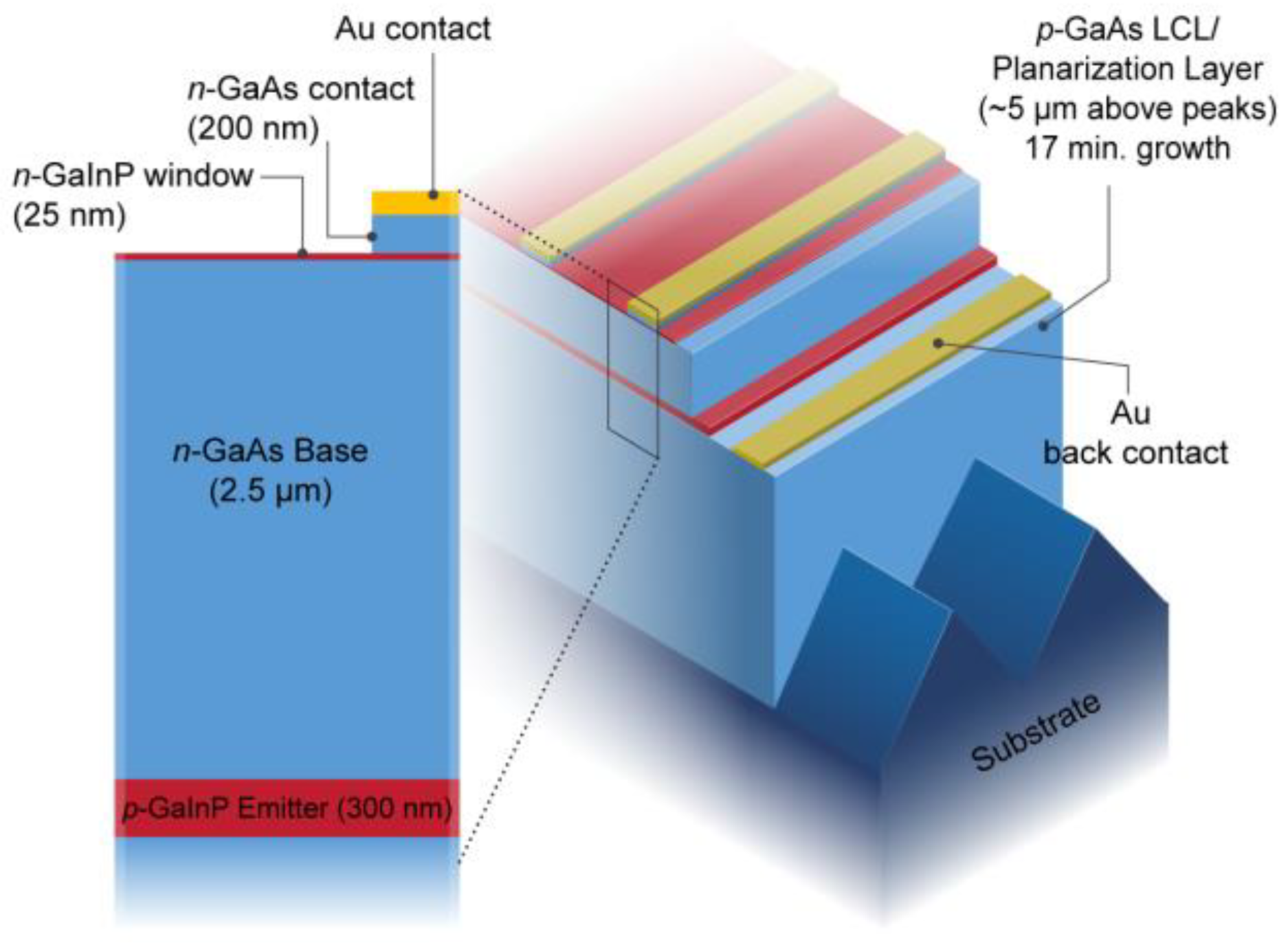



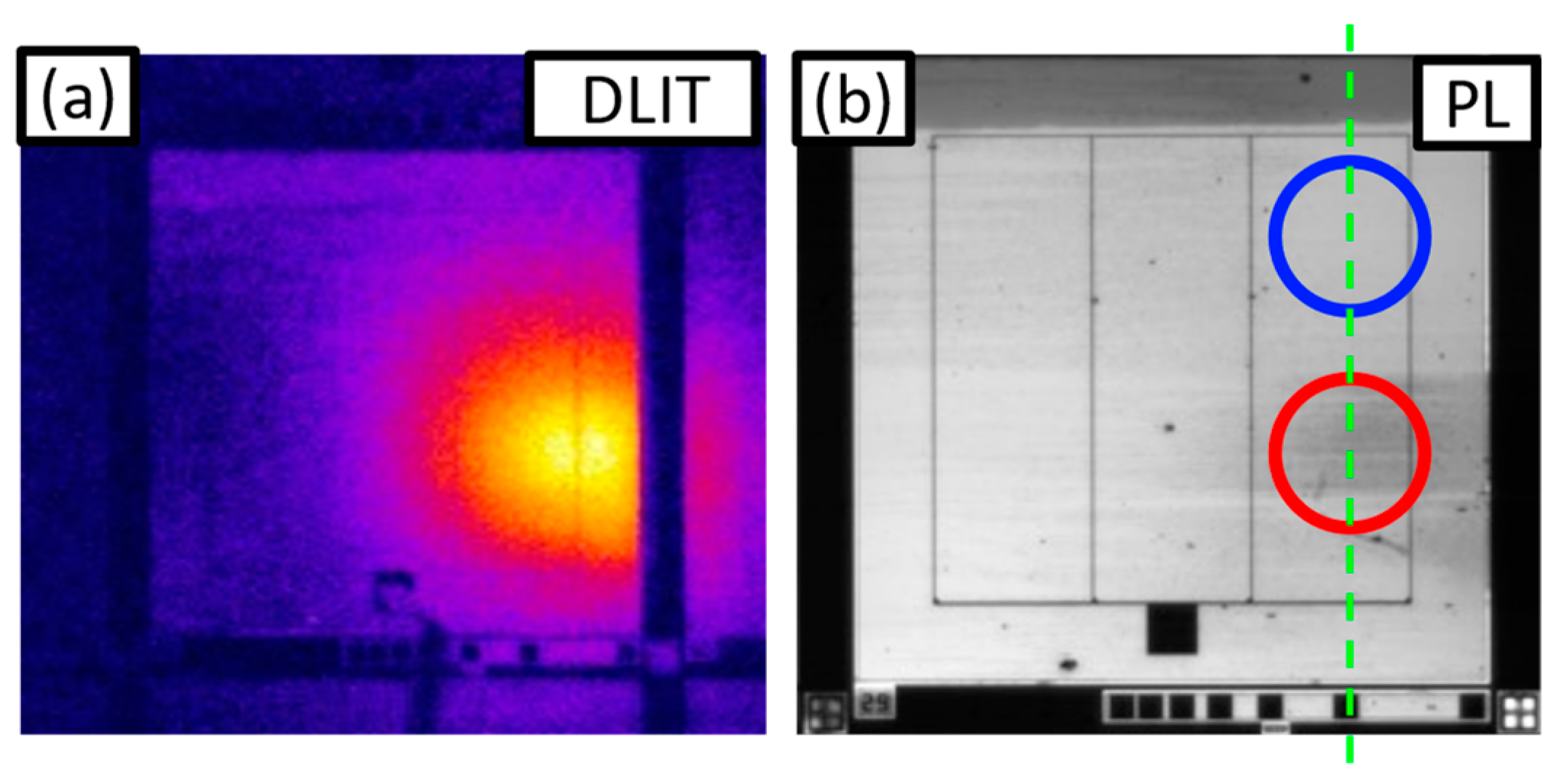
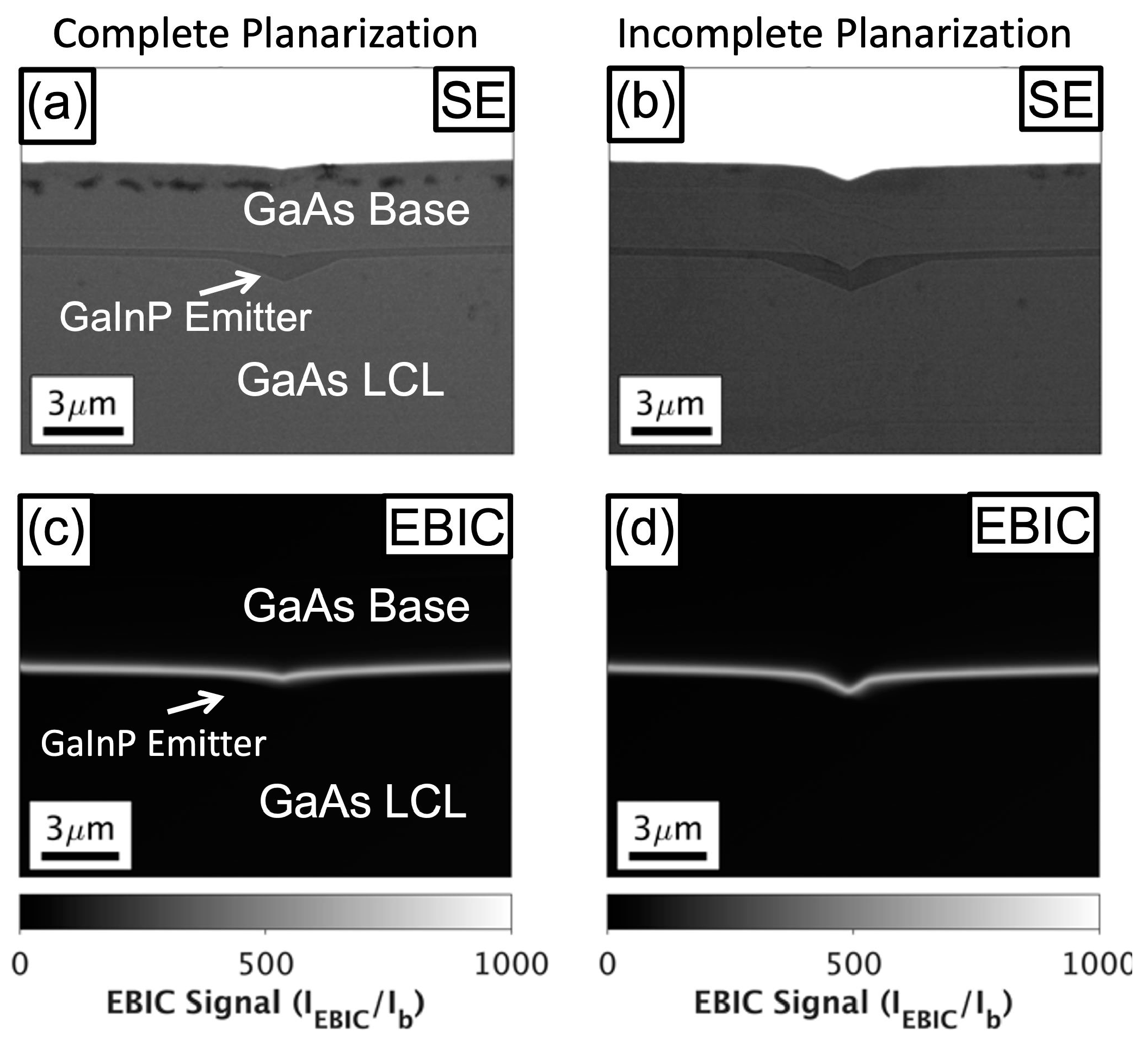
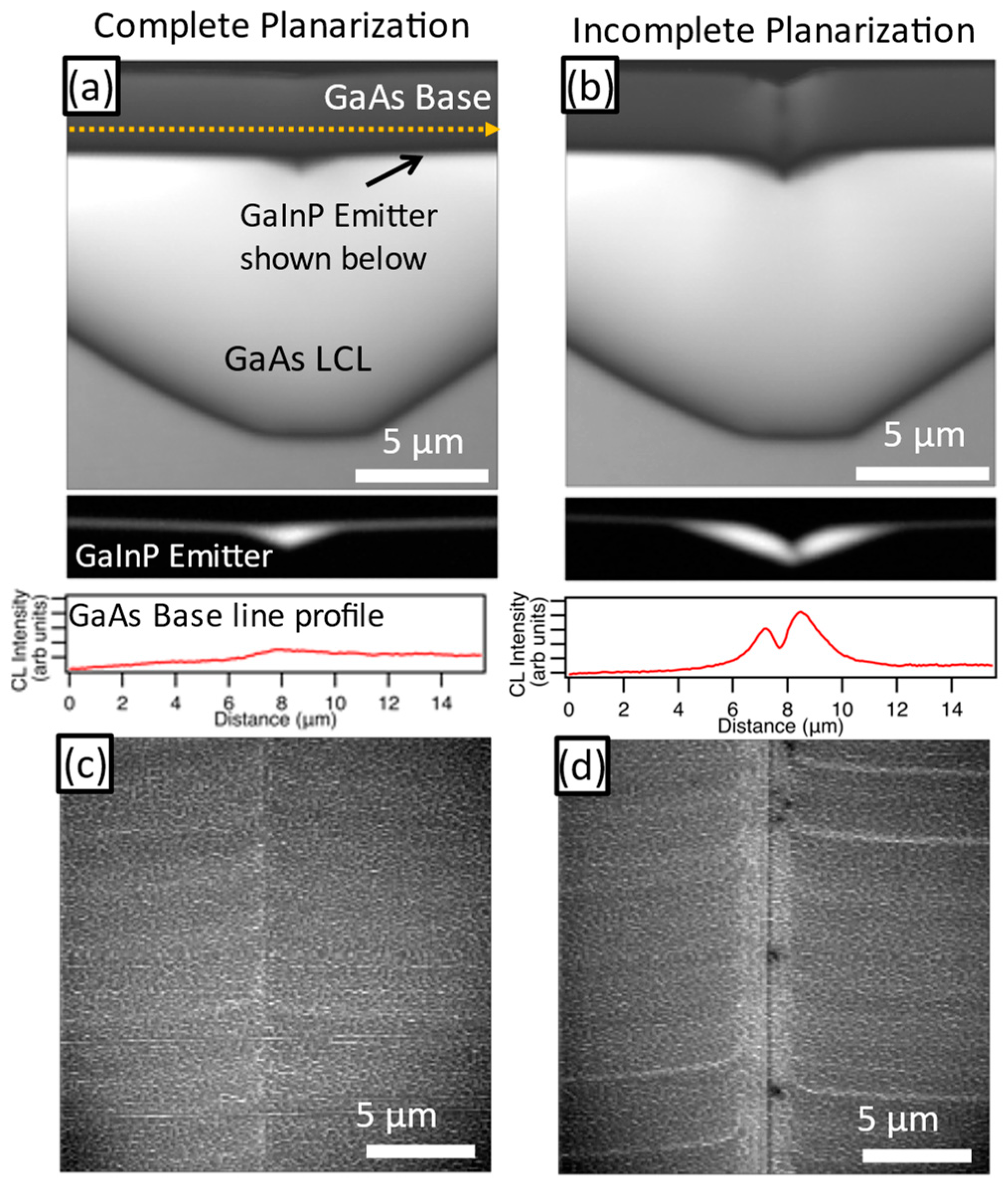
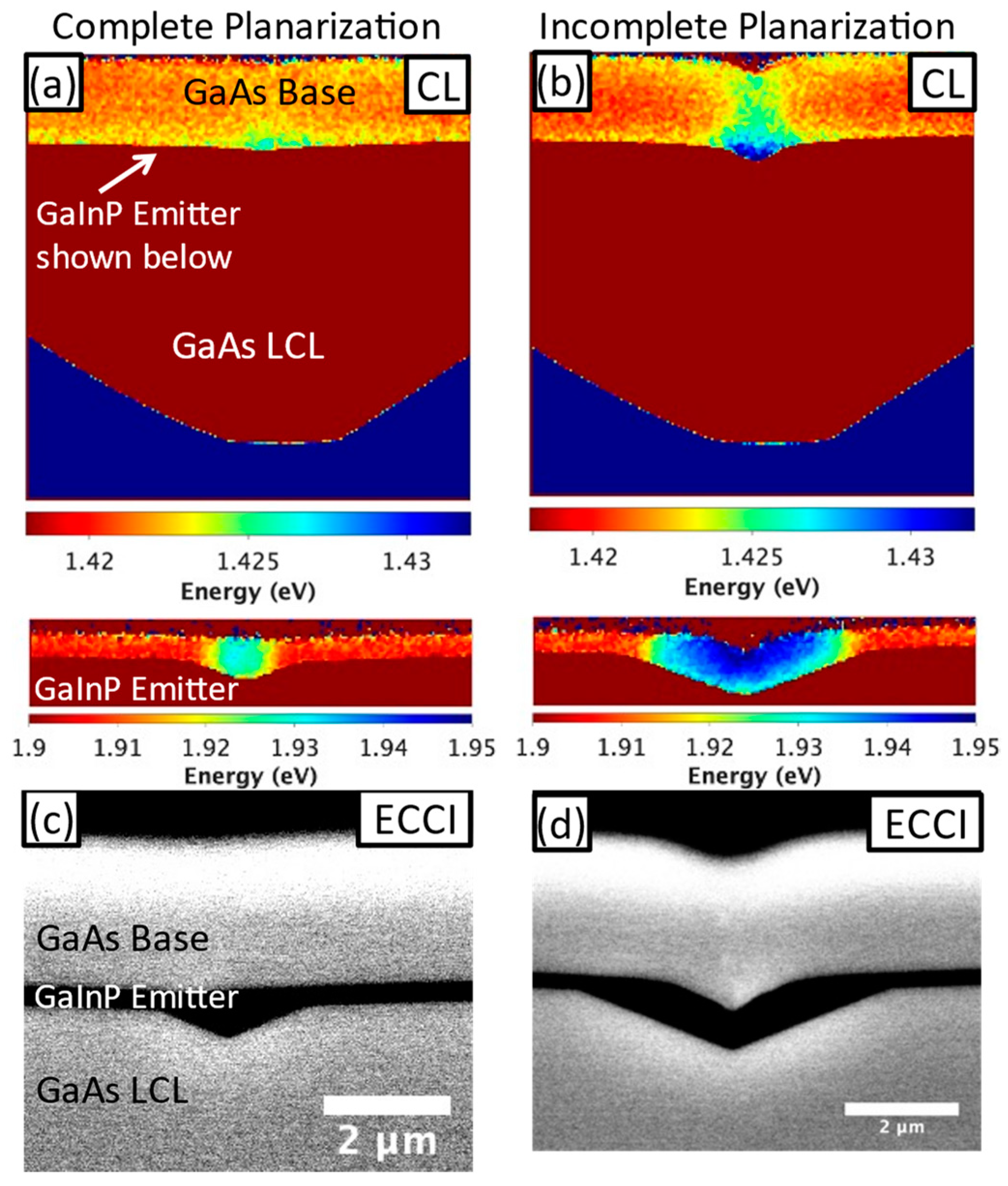
Disclaimer/Publisher’s Note: The statements, opinions and data contained in all publications are solely those of the individual author(s) and contributor(s) and not of MDPI and/or the editor(s). MDPI and/or the editor(s) disclaim responsibility for any injury to people or property resulting from any ideas, methods, instructions or products referred to in the content. |
© 2023 by the authors. Licensee MDPI, Basel, Switzerland. This article is an open access article distributed under the terms and conditions of the Creative Commons Attribution (CC BY) license (https://creativecommons.org/licenses/by/4.0/).
Share and Cite
Boyer, J.T.; Braun, A.K.; Schulte, K.L.; Simon, J.; Johnston, S.W.; Guthrey, H.L.; Steiner, M.A.; Packard, C.E.; Ptak, A.J. Analysis of Crystalline Defects Caused by Growth on Partially Planarized Spalled (100) GaAs Substrates. Crystals 2023, 13, 681. https://doi.org/10.3390/cryst13040681
Boyer JT, Braun AK, Schulte KL, Simon J, Johnston SW, Guthrey HL, Steiner MA, Packard CE, Ptak AJ. Analysis of Crystalline Defects Caused by Growth on Partially Planarized Spalled (100) GaAs Substrates. Crystals. 2023; 13(4):681. https://doi.org/10.3390/cryst13040681
Chicago/Turabian StyleBoyer, Jacob T., Anna K. Braun, Kevin L. Schulte, John Simon, Steven W. Johnston, Harvey L. Guthrey, Myles A. Steiner, Corinne E. Packard, and Aaron J. Ptak. 2023. "Analysis of Crystalline Defects Caused by Growth on Partially Planarized Spalled (100) GaAs Substrates" Crystals 13, no. 4: 681. https://doi.org/10.3390/cryst13040681
APA StyleBoyer, J. T., Braun, A. K., Schulte, K. L., Simon, J., Johnston, S. W., Guthrey, H. L., Steiner, M. A., Packard, C. E., & Ptak, A. J. (2023). Analysis of Crystalline Defects Caused by Growth on Partially Planarized Spalled (100) GaAs Substrates. Crystals, 13(4), 681. https://doi.org/10.3390/cryst13040681






